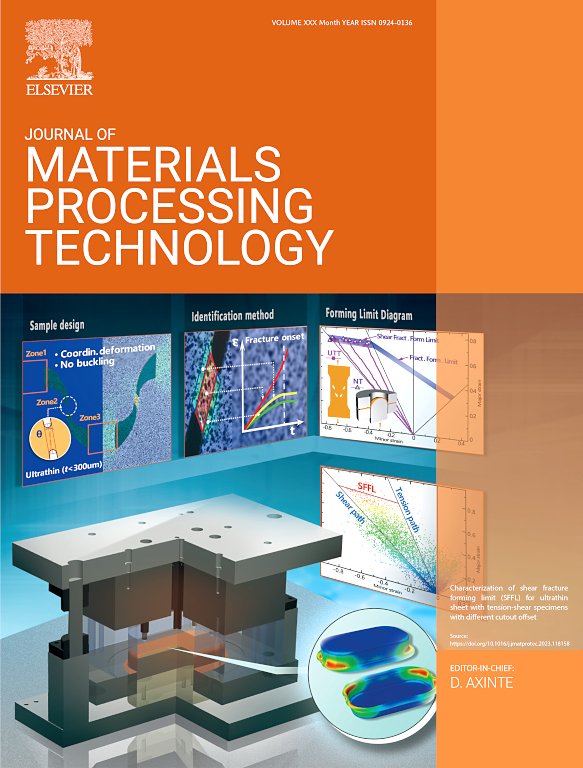Electrochemical jet machining in deep-small holes with gas assistance: Generating complex features on internal surfaces
IF 6.7
2区 材料科学
Q1 ENGINEERING, INDUSTRIAL
Journal of Materials Processing Technology
Pub Date : 2024-11-12
DOI:10.1016/j.jmatprotec.2024.118662
引用次数: 0
Abstract
Deep-small holes with internal features have important applications in thermal engineering but pose significant difficulties for traditional machining methods. Electrochemical jet machining (EJM) is an effective surface micromachining technique with numerous merits. Applying EJM to create complicated features on the internal surface of deep-small holes is attractive. However, this concept remains challenging due to the narrow and enclosed processing space. In this work, a novel gas assistance tool is developed to achieve the EJM process in deep-small holes for the first time. The hydrodynamic conditions to realize well-shaped and unsubmerged jets in both open space and deep-small holes using the specifically designed tool are investigated. The appropriate electrolyte flow rates and sidewall orifice dimensions enable the desired jet to be ejected laterally from the tubular cathode sidewall orifice. While in the deep-small hole the assist gas creates a local gas cavity around the orifice to prevent the jet from submerging, forming the jet shape required for EJM and consequently achieving localized machining of the internal surface. Excessive assist gas pressure should be avoided as it causes the jet to incline and deform, resulting in reduced machining accuracy. Furthermore, the influence of the main parameters on machining performance is examined. The developed gas-assisted EJM method demonstrates similar machining characteristics to the conventional EJM process when appropriate gas assistance conditions can produce the well-shaped unsubmerged jet. As such, various features with smooth surfaces and good shape accuracy are successfully machined on the internal surface of deep-small holes.
在气体辅助下进行深小孔电化学喷射加工:在内部表面生成复杂特征
具有内部特征的深小孔在热能工程中有着重要的应用,但却给传统的加工方法带来了很大的困难。电化学喷射加工(EJM)是一种有效的表面微加工技术,具有诸多优点。应用电化学喷射加工技术在深小孔的内表面加工出复杂的特征非常有吸引力。然而,由于加工空间狭窄且封闭,这一概念仍具有挑战性。本研究开发了一种新型气体辅助工具,首次在深小孔中实现了 EJM 工艺。研究了使用专门设计的工具在开放空间和深小孔中实现形状良好的非沉没射流的流体动力学条件。适当的电解质流速和侧壁孔口尺寸可使所需的射流从管状阴极侧壁孔口横向喷出。在深小孔中,辅助气体会在孔口周围形成一个局部气腔,以防止射流被淹没,形成 EJM 所需的射流形状,从而实现内表面的局部加工。应避免辅助气体压力过大,因为它会导致射流倾斜和变形,从而降低加工精度。此外,还研究了主要参数对加工性能的影响。当适当的气体辅助条件可以产生形状良好的非沉没射流时,所开发的气体辅助 EJM 方法显示出与传统 EJM 工艺类似的加工特性。因此,在深小孔的内表面上成功加工出了各种表面光滑、形状精度高的特征。
本文章由计算机程序翻译,如有差异,请以英文原文为准。
求助全文
约1分钟内获得全文
求助全文
来源期刊

Journal of Materials Processing Technology
工程技术-材料科学:综合
CiteScore
12.60
自引率
4.80%
发文量
403
审稿时长
29 days
期刊介绍:
The Journal of Materials Processing Technology covers the processing techniques used in manufacturing components from metals and other materials. The journal aims to publish full research papers of original, significant and rigorous work and so to contribute to increased production efficiency and improved component performance.
Areas of interest to the journal include:
• Casting, forming and machining
• Additive processing and joining technologies
• The evolution of material properties under the specific conditions met in manufacturing processes
• Surface engineering when it relates specifically to a manufacturing process
• Design and behavior of equipment and tools.
 求助内容:
求助内容: 应助结果提醒方式:
应助结果提醒方式:


